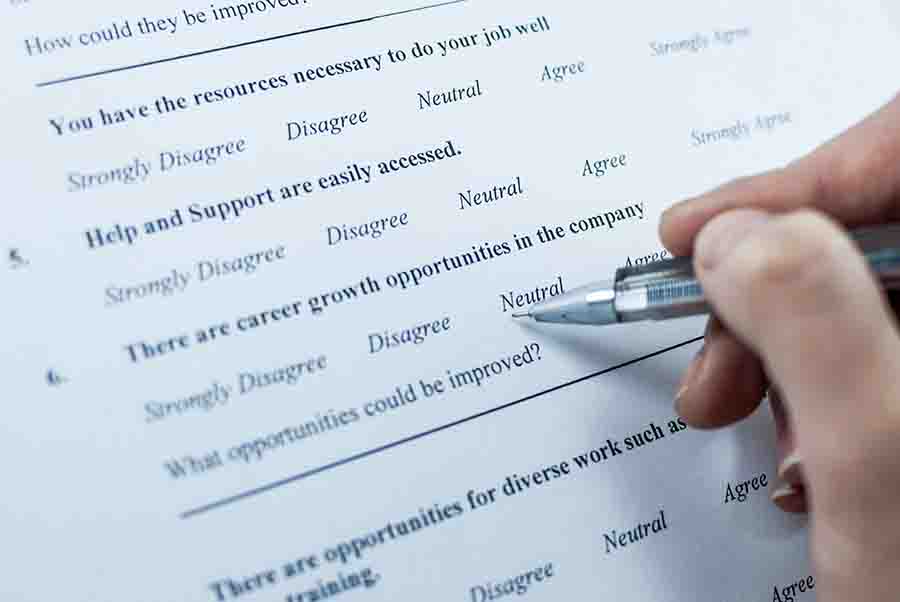An employee benefits survey is a tool for gathering feedback from workers about their company’s benefits package. By asking targeted questions about work-life balance, health coverage, retirement plans, professional development, childcare, and parental leave, you can pinpoint the benefits that matter most to your team and improve them for increased job satisfaction.
In this article, I outline essential employee benefits survey questions to help you align your benefits offering with employee expectations. Take note that you may need to customize some of these to align with the specific benefits you offer.
Key Takeaways:
- The type of questions you’ll use in your survey depends on your objectives and the information you want to gather.
- A well-designed survey involves a mix of different question types like open-ended, yes/no, and Likert scale.
- Use straightforward language to ensure that all respondents understand the questions.
Health Insurance
Health insurance is a cornerstone of employee benefits packages, significantly impacting worker satisfaction and well-being. The following survey questions are designed to assess employees’ perceptions, usage, and preferences regarding their health insurance benefits.
1. How satisfied are you with the current health insurance coverage? (Scale: 1-5, Very Dissatisfied to Very Satisfied)
2. How well do you understand your health insurance benefits (Scale: 1-5, Not at All to Very Well)
3. How often did you use your health insurance in the past year) (Never/1-3 times/4-6 times/7+ times)
4. Which of the following services have you used in the past year? (Select all that apply)
☐Primary care visits
☐Specialist visits
☐Emergency room
☐Hospitalizations
☐Prescription medications
☐Regular dental check-ups and cleanings
☐Periodontal treatments
☐Routine eye exams
☐Corrective lenses
5. How satisfied are you with the above coverage?
6. What additional health services coverage would you like included in our insurance plan? (Open-ended)
7. How satisfied are you with the following aspects of your health insurance? (Scale for each: 1-5 Very Dissatisfied to Very Satisfied)
-
- Monthly premium cost: ______
- Deductible amount: ______
- Co-pay amounts: ______
- Out-of-pocket maximum: ______
8. Do you feel our current health insurance provides good value for the cost? (Yes/No/Unsure)
9. If you answered No or Unsure in the previous question, please explain why. (Open-ended)
10. How easy is it to find in-network providers for our health plan? (Scale: 1-5, Very Difficult to Very Easy)
11. Have you experienced any issues with provider network coverage in the past year? (Yes/No)
12. If you answered Yes to the previous question, please briefly describe the issues you encountered. (Open-ended)
13. How would you rate the customer service provided by our health insurance carrier? (Scale: 1-5, Very Poor to Excellent)
14. Are you interested in any of the following additional health-related benefits? (Select all that apply)
☐Health Savings Account (HSA)
☐Flexible Savings Account (FSA)
☐Telemedic services
☐Wellness program
☐Fitness reimbursement
☐Other (please specify): ___________
15. Rank the following factors in order of importance when considering health insurance options: (Rank from 1-6, with 1 being the most important)
___ Low monthly premiums
___ Low deductibles
___ Wide network of providers
___ Comprehensive coverage
___ Low co-pays
___ Good customer service
Retirement Plans
Retirement plans are a crucial component of a comprehensive employee benefits package, providing financial security and peace of mind for your workforce’s future. The following questions cover key retirement plan benefits including current participation, plan features, employer contributions, education and support, and overall satisfaction.
1. How satisfied are you with the company’s current retirement plan options? (Scale: 1-5, Very Dissatisfied to Very Satisfied)
2. How would you rate your understanding of our current retirement plan options? (Scale: 1-5, Very Poor to Very Good)
3. Which of the following retirement plan features are the most important to you? (Select up to 3)
☐Employer matching contributions
☐Wide range of investment options
☐Low fees
☐Automatic enrollment
☐Roth 401(k) option
☐Emergency savings account
☐Others (please specify): _____________
4. What is your preferred contribution method?
-
- Traditional pre-tax contributions
- Roth after-tax contributions
- A combination of both
- I’m not sure
5. How satisfied are you with the current investment options in our retirement plan? (Scale: 1-5, Very Dissatisfied to Very Satisfied)
6. How important is an employer match to your decisions to participate in the retirement plan? (Scale: 1-5, Not Important to Very Important)
7. What type of employer contribution would you prefer?
-
- Fixed percentage match
- Graduate match based on years of service
- Profit-sharing contribution
- Other (please specify): ___________
8. Which retirement planning resources would be most helpful to you? (Select all that apply)
☐One-on-one financial counseling
☐Online retirement calculators and tools
☐Webinars or seminars on retirement planning
☐Regular account statements and performance reports
☐Mobile app for account management
☐Other (please specify): ___________
9. Do you have any suggestions for improving our retirement plan benefits? (Open-ended)
Paid Time Off
Paid time off encompasses various leave types, including vacation days, sick leave, personal days, and holidays, all of which play a crucial role in maintaining work-life balance and employee well-being. These survey questions aim to gather feedback on the adequacy and flexibility of your current time off policies as well as their impact on employee satisfaction and productivity.
1. Do you feel the number of PTO days you receive is adequate? (Yes/No/Unsure)
2. If you answered No or Unsure to the previous question, please explain why. (Open-ended)
3. On average, what percentage of your available PTO did you use last year?
-
- 0-25%
- 26-50%
- 51-75%
- 76-100%
If you didn’t use all your PTO last year, what were the main reasons? (Select all that apply)
☐Too busy at work
☐Saving days for future use
☐Difficulty coordinating with colleagues’ schedules
☐Concern about job security
☐Financial constraints
☐Other (please specify): ___________
5. How satisfied are you with the following aspects of our PTO policy? (Scale for each: 1-5, Very dissatisfied to Very Satisfied, N/A)
-
- Vacation days: ______
- Sick leave: ______
- Personal days: _____
- Holidays: _____
- Bereavement leave: _____
- Parental leave: _____
6. Does our current PTO policy offer enough flexibility to meet your needs? (Yes/No/Unsure)
7. If you answered No or Unsure to the previous question, please explain why? (Open-ended)
8. Have you ever had difficulty getting your PTO request approved? (Yes/No)
9. If you answered Yes to the previous question, please briefly explain the issues you encountered. (Open-ended)
10. Have you ever felt pressured to work while on PTO? (Yes/No/Sometimes)
11. How often do you check work-related communications (ex. email, messages) while on PTO? (Never/Rarely/Sometimes/Often/Always)
12. How important is the ability to carry unused PTO days to the next year? (Scale: 1-5, Not at All Important to Very Important)
13. Is there anything else you would like to share about your experience with our current PTO benefits? (Open-ended)
Professional Development Benefits
Professional development benefits encompass various learning opportunities and career growth initiatives that enhance employees’ skills, knowledge, and job satisfaction while simultaneously improving organizational performance. These benefits are crucial for both employees seeking career advancement and companies aiming to maintain a competitive edge through a highly skilled workforce.
1. Are you satisfied with the current professional development opportunities offered by the company? (Scale: 1-5, Very Dissatisfied to Very Satisfied)
2. In the past year, how many professional development activities have you participated in?
3. What types of professional development activities have you found most beneficial? (Select all that apply)
☐Online courses
☐In-person workshops
☐Conferences
☐Mentoring programs
☐Job shadowing
☐Industry certifications
☐Others (please specify): ___________
4. Which areas of professional development are you most interested in? (Select up to 3)
☐Technical skills related to your job
☐Leadership and management skills
☐Communication and interpersonal skills
☐Project management
☐Data analysis and interpretation
☐Creative thinking and innovation
☐Others (please specify): ___________
5. How often would you like to engage in professional development activities?
-
- Weekly
- Monthly
- Quarterly
- Annually
- As needed for specific projects or roles
6. What format do you prefer for professional development activities? (Rank from 1-6, with 1 being the most preferred)
___ Self-paced online courses
___ Live virtual workshops
___ In-person training sessions
___ One-on-one coaching
___ Group discussions and peer learning
___ Reading materials (books, articles, etc.)
7. How strongly do you agree with the following statement: “The professional development opportunities offered by the company align with my career goals.” (Scale: 1-5, Strongly disagree to Strongly Agree)
8. How has participating in professional development activities impacted your job performance? (Select all that apply)
☐Increased productivity
☐Enhanced problem-solving skills
☐Better collaboration with colleagues
☐Increased job satisfaction
☐No significant impact
☐Others (please specify): ___________
9. To what extent do you feel the company supports your professional growth? (Scale: 1-5, Very unsupportive to Very supportive)
10. What obstacles, if any, prevent you from utilizing the professional development benefits offered? (Select all that apply)
☐Lack of time
☐Workload pressures
☐Lack of awareness of available opportunities
☐Limited relevance to current role
☐Insufficient funding or resources
☐Lack of manager support
☐Others (please specify): ___________
11. Are there specific professional development opportunities you want added to our program?
Family-related Benefits
Family-related benefits are workplace perks designed to support employees’ family responsibilities and work-life balance, such as parental leave, child care assistance, and flexible scheduling. These benefits are crucial for attracting and retaining talented employees while promoting job satisfaction and work-life balance.
1. How satisfied are you with the current parental leave policy? (Scale: 1-5, Very Dissatisfied to Very Satisfied)
2. Do you currently use or need childcare services? (Yes/No)
3. Which child care benefits would be most valuable to you? (Rank from 1-5, with 1 being the most valuable)
___ On-site childcare facility
___ Childcare subsidies
___ Back-up childcare services
___ Dependent care flexible spending account
___ After-school program support
4. How important is work flexibility in managing your family responsibilities? (Scale: 1-5, Not important to Extremely Important)
5. Which flexible work arrangement would you find more beneficial? (Select all that apply)
☐Flexible start/end times
☐Compressed work week
☐Part-time options
☐Job sharing
☐Remote work options
6. How would you rate your current work-life balance? (Scale: 1-5, Very Poor to Excellent)
7. Which of the following would help improve your work-life balance? (Select all that apply)
☐Reduced work hours
☐No-meeting days
☐Sabbatical options
☐Paid time off for family events
☐Other (please specify): ________
Creating Your Own Benefits Survey Questions
The quality of your survey data depends heavily on how well your questions are structured. To ensure that your survey yields valuable insights and actionable data, you need to choose the right questions and flow.
There are several question types, such as multiple choice, yes/no, Likert, rating scale, and matrix. When choosing the best for your survey, consider:
- Your objectives
- The nature of the information you’re seeking
- Your target audience (how much time they have, the relevance of the questions to them, etc.)
- The time it will take to complete the survey
- Your end goal (Is it for statistical analysis, exploring new ideas, or measuring specific attitudes?)
Importance of Using Clear and Unbiased Questions
When crafting questions for your employee benefits survey, it is important to avoid leading or loaded questions, which can subtly push respondents towards a particular answer, thereby skewing the results. Such questions often contain assumptions that can influence the respondent’s thinking.
Here’s an example:
“Don’t you agree that our generous healthcare plan is the best part of our employee benefits package?”
Instead, you can ask: “How would you rate your satisfaction with the following aspects of our employee benefit package? (Rate on a scale of 1-5, from Very Dissatisfied to Very Satisfied).
This yields a more transparent and objective answer from your employees. Also, each question should ideally ask about only one thing at a time, avoiding the common pitfall of double-barrelled questions that combine multiple issues into a single query.
Employee Benefits Survey Frequently Asked Questions (FAQs)
Employee benefits surveys gather feedback about the company’s benefits package. Typically administered by the human resources department or a third-party survey provider, these surveys usually contain 20 to 50 questions and take 10 to 15 minutes to complete. These are often sent out annually or bi-annually to assess satisfaction, identify improvement areas, and inform benefits decisions.
Employee benefits surveys are crucial for understanding workforce needs and preferences. They provide valuable insights that help organizations tailor their benefits packages to improve employee satisfaction and retention. These surveys also demonstrate that the company values employee input, potentially boosting morale and engagement.
Employee benefits surveys should be conducted annually to stay current with changing needs and market trends. However, some organizations may opt for bi-annual surveys to allow more time for implementing changes between assessments. The frequency may also depend on factors such as company size, industry dynamics, and the pace of change in the benefits landscape.
All employees in your organization should be invited to complete the benefits survey, regardless of their position or employee status. This inclusive approach ensures a comprehensive view of the workforce’s needs and preferences, leading to a more effective and equitable benefits planning.


